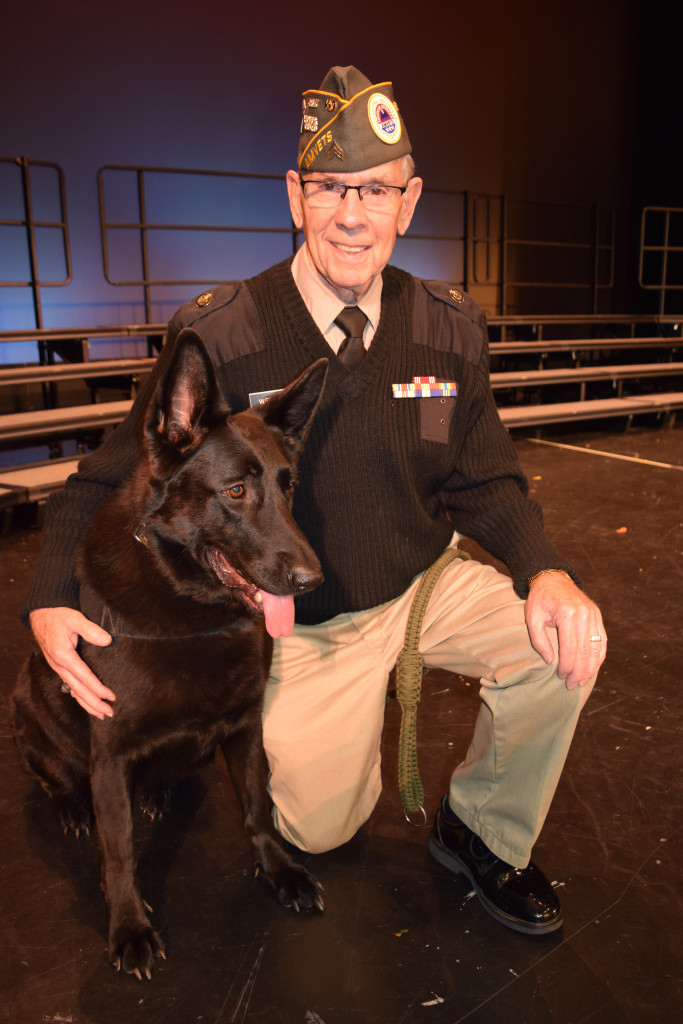
With Veterans Day approaching this Saturday, Phil Weitlauf is asking folks to remember the vital role dogs have played, and continue to play, in military operations.
“Let us not forget the four-legged veterans,” he said. “They’re well-trained. They’re loyal. They’re brave. And they’ve been fighting alongside our men and women in uniform ever since World War I.”
Weitlauf, president and director of Michigan War Dog Memorial (MWDM), was one of the guest speakers during Friday night’s Americana Concert held at Oxford High School’s Performing Art Center.
MWDM is a nonprofit organization that works to educate the public about the “heroics and dedication” of canines who serve and protect people. The actual memorial site is located at 25805 Milford Rd., near 11 Mile Rd., in Lyon Township.
Inspired and impressed by the success of military dogs used by its French allies during WWI, the United States decided to establish its own canine program in March 1942 to help fight the Axis powers in the Second World War.
A call was put out to the nation and patriotic citizens donated more than 20,000 dogs for the new program, according to Weitlauf, who noted the Marines preferred Doberman Pinschers, while the army preferred German Shepherds.
“All the Chihuahuas had to be sent back,” joked Weitlauf. “They just didn’t make the cut.”
In spring 1943, the first dog platoon was deployed to the island of Guam in the Pacific Theater of Operations.
Weitlauf said two weeks after the dogs’ arrival, the number of American casualties on Guam dropped 70 percent.
“In 550 missions led by a war dog, not one, not one, was ambushed,” he said. “Due to their superior nose, eyes and ears, they could detect the enemy over 200 yards away.”
Military records indicate war dogs saved 15,000 lives during WWII, plus 3,000 lives in the Korean War and an additional 10,000 during the Vietnam War, according to Weitlauf.
“They do a fantastic job,” he said.
Today, there are more than 2,800 military canine teams scattered across the globe.
Unfortunately, war dogs weren’t always as valued as they are now.
When the Vietnam War was drawing to a close, military canine handlers were excited because they thought they were going to be taking their “battle buddy” home with them, said Weitlauf, a Vietnam Era veteran of the U.S. Army.
Then, the order came down from Washington D.C. to “leave the dogs” behind.
Weitlauf said the bureaucrats were afraid the military dogs would bring back diseases from Vietnam and it would be a “logistical nightmare” to transport them to the states.
Back then, the military establishment considered dogs to be nothing more than equipment, no different than a rifle or a jeep.
Their handlers had a choice, either leave the dogs with the South Vietnamese army or “put them down.”
Weitlauf said 95 percent of the handlers cared too much about their dogs to leave them in the hands of the Vietnamese military, so they chose to end their lives.
“They walked into the tent with their dog and walked out with a collar and leash in hand,” he said.
“Such a sad, sad story.”
As a tribute to the 4,234 military dogs who served in Vietnam, the MWDM erected a black granite wall with all of their names and tattoo numbers listed on it. It was dedicated in June of this year.
Things are different these days and Weitlauf told the audience, “I’m happy to tell you that (what occurred in Vietnam) will never, ever happen again.”
Under federal law, all retired military dogs are now eligible for adoption and every reference to them as “equipment” was “scrubbed” from Department of Defense documents.
“They’re now considered canine members of the Armed Forces,” Weitlauf said. “And that’s why we respect them.”
The MWDM site started as an abandoned and neglected pet cemetery containing a large granite monument bearing the words “The War Dog.” It was erected as a tribute to military dogs who served in WWI and WWII.
Volunteers came together to restore the forgotten cemetery and convert it to the Michigan War Dog Memorial, which was dedicated in November 2011.
In 2012, MWDM received permission from Lyon Township to continue interring dogs there, but only service dogs.
“They will get a full-blown ceremonial burial,” said Weitlauf, which includes a group of eight German Shepherds who have been trained to “howl on command” as a “canine salute” to their fallen comrades.
Canines eligible for interment at the MWDM include military dogs, police dogs, service dogs who assist the disabled, search-and-rescue dogs, therapy dogs and companion dogs for veterans coping with post-traumatic stress disorder.
“These are the dogs that we take care of,” Weitlauf said. “So far, we have interred 18 of them since we started.”
For more information about Michigan War Dog Memorial, please visit www.mwdm.org or call (248) 685-8307.

Leave a Reply